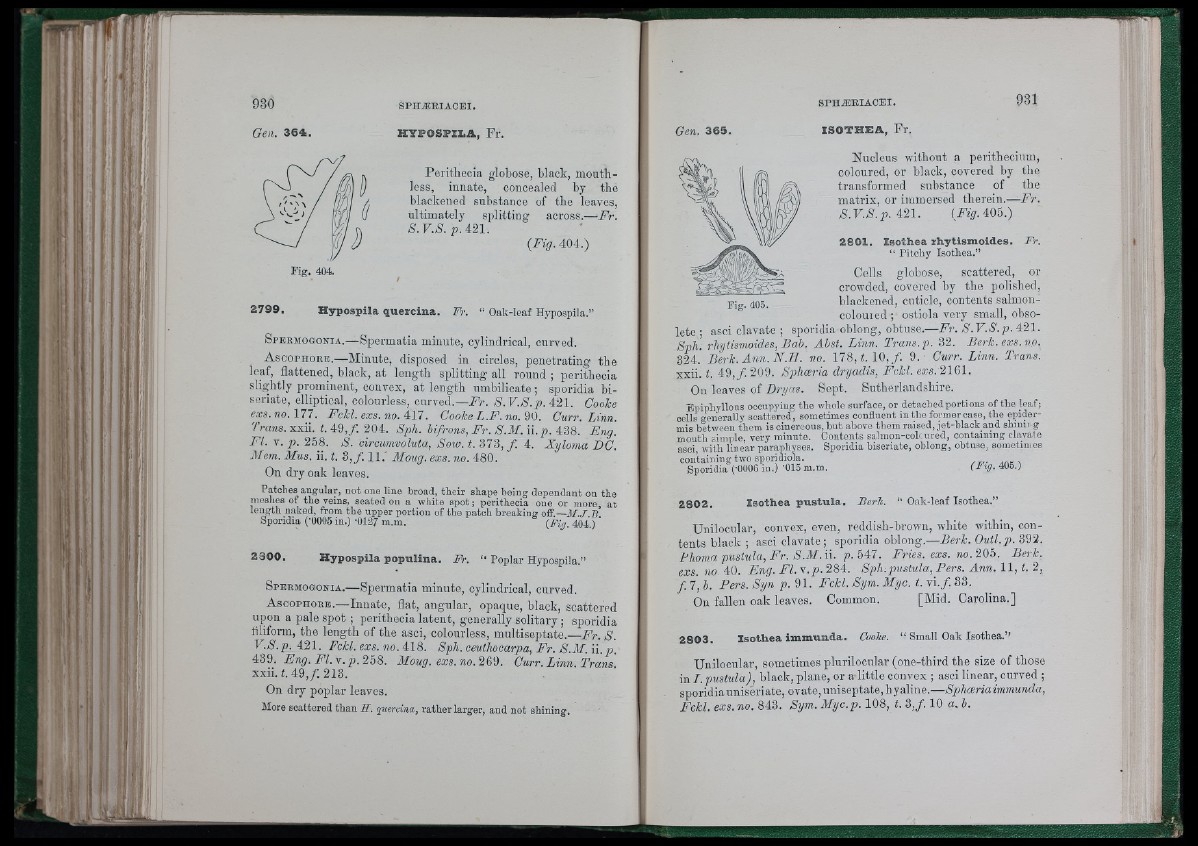
BÎ ¡I m I il
W -î B •|: ^ iï
r T
i l # Gen. 3 6 4 . H ÏF O S F IL A , Fr.
Peritliecia globose, black, mouthless,
innate, concealed by the
blackened substance of the leaves,
ultimately splitting across.—Fr.
S .V .S . 11.421.
(Fig. 404.)
P ig . 404.
2 7 9 9 . H y p o sp ila qu exc in a . Fr. “ Oak-leaf Hypospila.”
S p e r m o g o n ia .— Spermatia minute, cylindrical, curved.
A s c o p h o r e .— Minute, disposed in circles, penetrating the
leaf, flattened, black, at length splitting all round ; perithecia
slightly prominent, convex, at length umbilicate; sporidia biseriate,
elliptical, colourless, curved.—Fr. S .V .S .p . 421. Cooke
e.xs. no. 177. Fckl.exs.no. 417. Cooke L .F. no. 90. Curr.Linn.
Trans.xxii i.4 9 ,/. 204. Sph. hifrons, Fr. S .M .i lp . 438. Fng.
Fl. V. p. 258. S. circumvoluta, Sow. t. 373, f . 4. Xyloma DC.
Mem. Mus. ii. t. 3 ,f. 11.' Along, exs. no. 480.
On dry oak leaves.
Patches angular, not one line broad, tlicir shape being dependant on the
nieslíes of the veins, seated on a white spot; perithecia one or more at
length naked, from the upper portion of the patch breaking oñ.—M.J.B
Sporidia (*0005 in.) *0127 m.m. {Fig. 404.) "
2 3 0 0 . H y p o sp ila p o p u lin a . Fr. “ Poplar Hypospila.”
S p e r m o g o n ia .— Spermatia minute, cylindrical, curved.
A s o o p h o r e .—Innate, flat, angular, opaque, black, scattered
upon a pale spot ; perithecia latent, generally solitary ; sporidia
filiform, the length of the asci, colourless, multiseptate.—Fr. S.
V.S. p. 421. Fckl. exs. no. 418. Sph. ceuthocarpa, Fr. S.AI.ii. p.
439. Fng. Fl. v .p . 258. Moug. exs. no. 269. Citrr. Linn. Trans.
xxii. t. 49, f . 213.
On dry poplar leaves.
More scattered than H. quercina, rather larger, and not shining.
Gen. 3 6 5 . ISO TH EA , Fr.
Nucleus without a perithecinm,
coloured, or black, covered by the
transformed substance of the
matrix, or immersed therein.—Fr.
S .V .S .p . 421. {Fig. 405.)
2 6 0 1 . Iso th e a xhytismoides.
“ Pitchy Isothea.”
Fr.
Fig. 405.
Cells globose, scattered, or
crowded, covered by the polished,
blackened, cuticle, contents salmon-
coloured ; ostiola very small, obsolete
; asci clavate ; sporidia oblong, obtuse.—Fr. S .V .S .p . 421.
Sph. rhyiismoides, Bab. Abst. Linn. Trans, p. 32. Berk.exs.no.
324. Berk. Ann. N.H. no. 178, i. 1 0 ,/. 9. Curr. Linn. Trans.
xxii. t. 4 9,/. 209. Sphæria dryadis, Fckl. exs. 2161.
On leaves of Dryas. Sept. Sutherlandshire.
Epiphyllous occupying the whole surface, or detachedportions of the leaf;
cells generally scattered, sometimes confluent in the former case, the epidermis
between them is cinereous, but above them raised, jet-black and shiiiii g
mouth simple, very minute. Contents salmon-eoh ured, contaimng clavate
asci, with linear paraphyses. Sporidia biseriate, oblong, obtuse, sometimes
c o n ta in in g two sporidiola.
Sporidia (-0006 in.) -015 m.m. (F ÿ - 405.)
2 8 0 2 . Iso th e a p u s tu la . Berk. “ Oak-leaf Isothea.”
Unilocular, convex, even, reddish-brown, white within, contents
black ; asci clavate ; sporidia oblong.—Berk. Outl.p. 392.
Bhoma pustula, Fr. S.AI. ii. p. 547. Fries, exs. no. 205. Berk,
exs. no. 40. Eng. Fl. v.p. 284. Sph.pustula, Bers. Ann. 11, t. 2,
f. 7, b. Pers. Syn p. 91. Fchl. Sym. Myc. t. v i.f. 33.
On fallen oak leaves. Common. [Mid. Carolina.]
2 8 0 3 . Iso th e a iiumund a . CuoTte. “ Small Oak Isothea.”
Unilocular, sometimes plnrilocnlar (one-third the size of those
in I. pustula), black, plane, or a little convex ; asci linear, curved ;
sporidia uniseriate, ovate, uniseptate, hyaline.—Sphceriaimmunda,
Fckl. exs. no. 843. Sym. Alyc.p. 108, t. 3,f. 10 a. b.